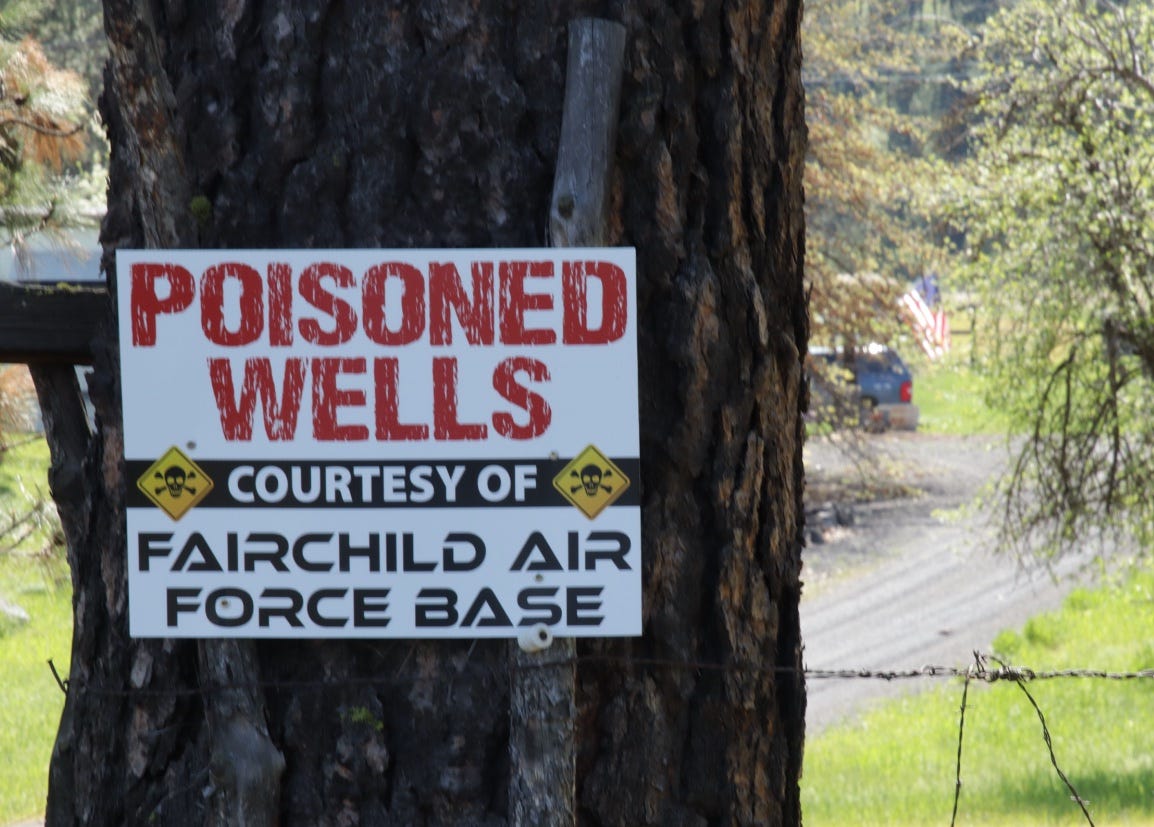Palouse River canyon, looking southward downstream from the falls
Something in the water
I don’t usually write stories about stories I haven’t finished yet. This is especially true when it comes to complex, investigative assignments such as the once-secret radiation releases from Hanford, or the camouflaged fraud in Spokane’s River Park Square public-private partnership.
The early steps in such labyrinthine stories are often tentative and puzzling. It can be tantamount to searching for water leaks in a darkened basement with a small flashlight. Especially early in the process, it can be discouraging and, at times, overwhelming. Imagine someone giving you a 5,000 piece jigsaw puzzle, taking the cover off a box without a picture on it, and then broadcasting the pieces all over the floor. It can seem like that.
When the City of Airway Heights discovered it had high levels of dangerous “forever chemicals” in its drinking water six years ago, I honestly wasn’t paying much attention. I was writing about a complex legal story at the time and wrestling with a family crisis that would soon be all-consuming. It was already enough to lose sleep over. Also, I don’t live in Airway Heights. I live seven miles to the east, in Spokane, where we get copious amounts of really clean water from a prolific aquifer.
Protest sign along Garfield Road in the Deep Creek area where several private wells have tested for high levels of the toxic, “forever chemicals” in fire-fighting foam.
As I’ll explain in due course, it was a friend of mine who opened my eyes to the Airway Heights/West Plains contamination story, and the dangerous chemicals in the water. It’s an alarming local story attached to a broader tragedy, one that goes well beyond Airway Heights.
Two days ago the New York Times reported on what is at least a partial settlement to a massive, class-action lawsuit brought by plaintiffs throughout the U.S. that, like Airway Heights, have had their municipal water systems contaminated with synthetic “forever chemicals.”
From the Times article:
“The companies — Chemours, DuPont and Corteva — said they had reached an agreement in principle to set up a $1.19 billion fund to help remove toxic perfluoroalkyl and polylfuoralkyl substances or PFAS, from public drinking water systems. PFAS have been linked to liver damage, weakened immune systems and several forms of cancer, among other harms, and are referred to as forever chemicals because they linger in the human body and the environment.
Bloomberg News also reported on Friday that 3M had reached a tentative deal worth “at least $10 billion” with U.S. cities and towns to resolve related PFAS claims. Sean Lynch, a spokesman for 3M, declined to comment on the report, which cited people familiar with the deal without naming them.”
It’s unclear, as yet, how many of the legal claims filed on behalf of people exposed to contaminated water at and near Airway Heights are involved in the settlement. But, on its face, it’s evident the settlement will not resolve the claims brought by those whose private wells were contaminated.
More importantly, here in Lilacland, the bounds and ramifications of the contamination on the West Plains are not yet clear.
Before I go further, I will simply insert that if you live on the West Plains and get your water from a well you should have it tested--if you haven’t already—by an accredited lab for the suite of PFAS chemicals. You can learn more about PFAS and what Washington state is doing to address PFAS contamination here. You can also stay abreast of news and local developments by connecting with the new, non-profit grassroots citizen group, the West Plains Water Coalition.
Although PFAS chemicals have been used for decades in consumer products (teflon pans, food packaging, stain-resistance rugs and apparel, etc.) it’s already clear the source of the water contamination at Airway Heights and the West Plains is aviation—certainly Fairchild Air Force Base and most likely Spokane International Airport as well.
The contamination has been linked to aviation fire fighting and fire fighting training, both of which released large amounts of Aqueous Film Forming Foam (AFFF)—a suppressant loaded with the PFAS chemicals. The PFAS cocktail includes a variant with a long biological half-life—Perfluorohexane sulfonic acid (PFHxS)—that was measured at extraordinarily high concentrations in blood samples taken from Airway Heights residents by federal public health officers shortly after the chemicals were detected in Airway Heights drinking water. (In 2018, Washington state became the first state to restrict the use of the AFFF foam because of the potential for PFAS contamination of surface and groundwaters.)
In short, this story sprawls. It most certainly connects to a broader public health tragedy, the dark twist of a widely used suite of chemicals—intended to make our lives safer and more convenient—that turns out to be a fiendish endocrine disrupter and carcinogen. It raises national and statewide issues that I’ll certainly incorporate into the reporting.
But it also raises important local questions—questions about state and local governments and their responses to the contamination problem on the West Plains. Spokane may have its own aquifer that is (fortunately for Spokane) upstream from the contamination source and physically separated from it. But, in a geopolitical sense, what happens on the West Plains doesn’t just affect the West Plains. The expansive growth on the West Plains is a major political/governmental priority in Spokane County, one that affects the natural and sociological environment in a variety of ways. Even before the PFAS contamination was discovered, Airway Heights and the rest of the West Plains were struggling to provide for the water for the rapidly growing residential and commercial development.
Ironically, Fairchild Air Force Base was already being served by water being piped up to the base from Spokane. Now, because of the PFAS contamination, Airway Heights also gets its water piped up from Spokane. Spokane’s water supply is not boundless and draws from the Spokane Valley/Rathdrum Prairie aquifer inevitably subtract from streamflows in the Spokane River, especially in the summer and fall when seasonal streamflows can be perilously low.
The basic question is how did this happen? How did it take so long for us to begin to move to protect people from the dangerous chemicals in their water?
And why is it taking so long to learn about the extent of groundwater contamination on the West Plains, and provide protection and redress?
There were several government entities—at federal, state, and local levels—with nominal responsibilities to protect public health. But politics can shape and sometimes interfere with environmental regulation and public health protection, and I’ve witnessed and experienced this directly as a member of a national scientific panel studying radiation casualties from nuclear weapons production/testing.
There’s still a ways to go to protect folks on the West Plains from poisoned water. Moreover, there ought to be several lessons learned to ensure something like this won’t happen again.
That’s the basic outline of my work on this—subject to change of course as I learn more. There are important human stories in this saga that remind us of the stakes involved.
On a practical level here—within the context of The Daily Rhubarb and the time it takes to dig into a complex story like this—it will doubtless affect my writing and posting schedule. I’ll ask for your patience, and your support, of course.
—tjc







Karen, thanks for your comment. "What will the community do, even if they win a huge settlement?"--good question. I can give you a partial answer and hope to improve on it with future reporting. The Air Force has been offering and providing certain private well owners with filtration equipment to remove the "forever chemicals" from their well water. But the contracts come with strings attached and, for example, prohibit the use of the filtered water for garden irrigation, which is a problem because putting contaminated water on gardens actually concentrates the hazardous chemicals in the produce, making it unsafe to consume. Those who refuse the contracts can get bottled water delivered to them at the Air Force's expense. However, the process by which the Air Force chooses to accept responsibility for contaminated wells on the West Plains is murky, at best, and not all well owners with contaminated water have been offered relief, either in treatment systems for well water or for bottled water deliveries. So, you're right, the questions about the future (especially for private well owners) remain unanswered.
Thank you for working on this story. I saw the NYT article you referenced, after hearing about the contaminant situation in Airway Heights. When they say "Forever Chemicals", it seems to imply they will always be there. What will the community do, even if they win a huge settlement? Sure, the dumping of the chemicals will cease but that's small comfort to those who live there, if their water is undrinkable. Yet, every small town surrounding Spokane can't keep adding straws in the aquifer as they expand their growth boundaries, especially as Spokane continues to stretch, instead of becoming more compact. So many issues at play and all need solutions as unpolluted land and water become more scarce.